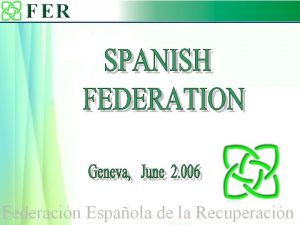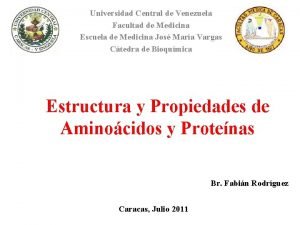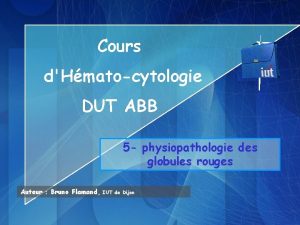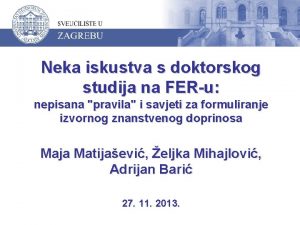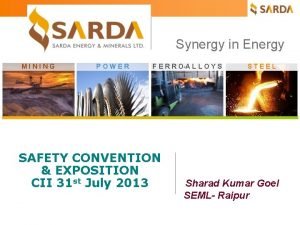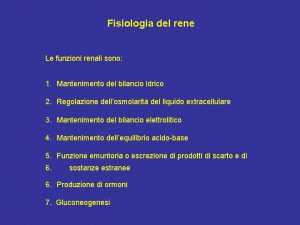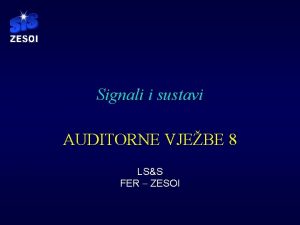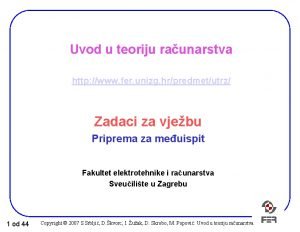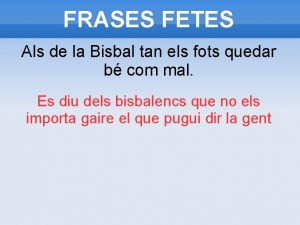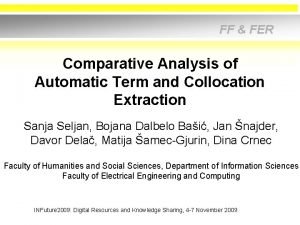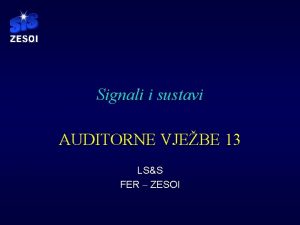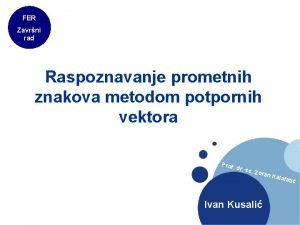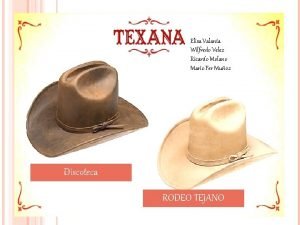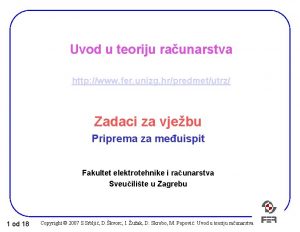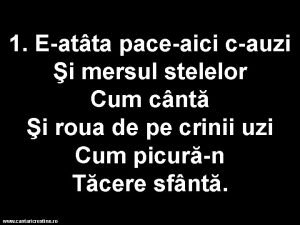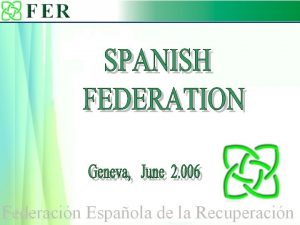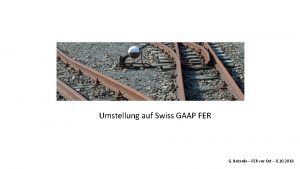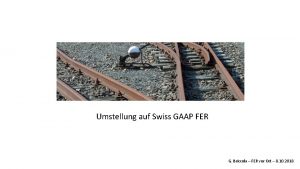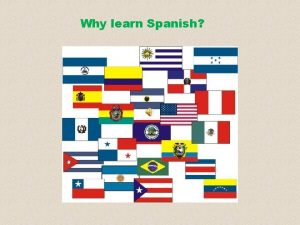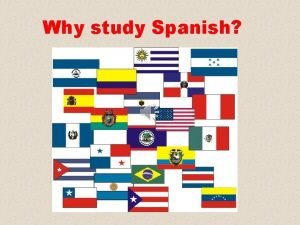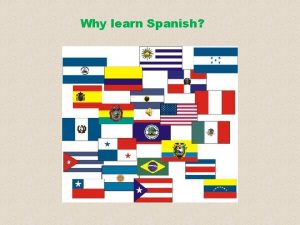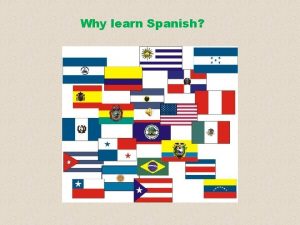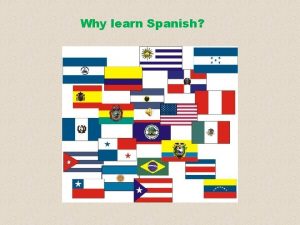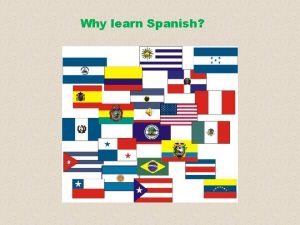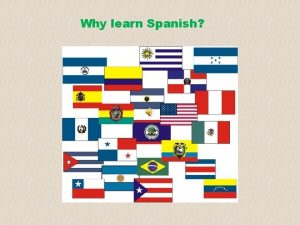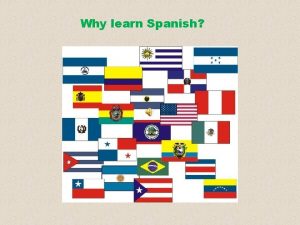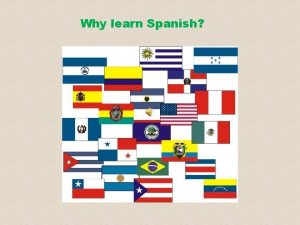Spanish Federation of Recovery FER The Federation of



















- Slides: 19


Spanish Federation of Recovery (FER) • The Federation of Spanish Recovery sector was born in 1982 in order to represent the recycling (recovery) sector in the economic, technical and social fields. The Federation represents the sector before the civil service (environmental Ministry, industry Ministry, etc) and other private organizations and institutions. Now-a-days, more than 170 companies of the sector and many regional associations (ARA, ARMETAL, RECOMETAL, ARYCAT Y RECUMUR) are members of FER • FER is Member of the Bureau of International Recycling (BIR), of the European Ferrous Recovery and Recycling Federation (EFR) and of the European Metal Trade and Recycling Federation (EUROMETREC). • FER has participated in several projects concerning the packaging recycling, the ELV’s, the WEEE’s, the ELT, ect

Protocol of Radiological Surveillance The Spanish protocol was born in 1999, just after the agreement signed by the main agents involved in the radiological surveillance of metallic materials: • The Federation of Spanish Recycling, as recycler’s representative • UNESID, as iron and steel industry’s representative • Industry Ministry, as civil service’s representative • Infrastructures Ministry, as commercial port’s representative • Nuclear Security Council, as superior institution with competence (authority) in nuclear matter • The National Company of radioactive management waste (ENRESA), institution charged to handle the radioactive waste • The representation of other industrial sectors has joined the agreement, as FEAF (small smelting), UNIPLOM (lead refiners), ASERAL (aluminium refiners

Companies joined to the protocol Up to now, there are 79 recycling companies, 26 iron and steel industries, 2 smelting companies and 2 aluminium refining companies as signers of the protocol; however the number of companies which support it increases. Information campaigns from the adhered associations have a positive influence on new companies support Moreover, through the free courses offered, the recycling companies could approach the problem of radioactivity, which was unknown, attaching it the importance it has. They value the magnitude of the problem and they get involved in the radiological surveillance. At last, any incidents in a recycling plant and in several iron and steel companies have the companies made to become aware of the risks if they do not control the source of supply.

Companies joined to the protocol FER advises its members, arranges all the papers requested for the adherence, provides the procedure and protocols to be followed and give courses. FER also provides agreements with supplier services companies of radiological protection to take control of the situation in case of radiological source detection ant to buy mechanisms of radiological surveillance

Detections. Thanks to the work made by these companies, there is a control net with better systems. On this way, the radiological materials are removed with a control and they are increasing as more companies join the protocol. In 1999, there were 54 notices, in 2000 were 50, in 2001 were 47, in 2002 were 72, in 2003 were 141 and in 2004 were 129. It is important to emphasize that those notices are not always source; the “NORM” are also included here. The amount of sources removed, which entail a potential danger for the persons and institutions, is unstable, but we could speak of 10% to make it a round number

Dynamic and flexible Application The good working is the key of the Protocol. It is put in practice in a flexible way and with good judgment to everybody. The performance of the teamwork groups (with representatives of every single sector) is essential.

Dynamic and flexible Application They, as agents involved in the mechanism, know who address, what to do and how to do effectively. It allows them to act quickly not only in case of detection of radioactivity in the entry of a company but also in case of incorporation of a source in the process and its contamination, minimizing the consequences. The existence of procedure established previously makes possible to take immediate actions, improve the coordination and reduce the waste and the stop of the plant.

Expenses The companies take charge of expenses of the detectors appliances, and the industry sector has claimed subventions for these acquisitions but there is not any help up to now. They also assume the expenses of detection of sources: its correct detection and description by their own ways or through a UTPR and its temporal storage. If the companies attached to the protocol detect a source or national NORM, the civil service assumes the expenses of the correct treatment of the source, treatment developed by Enresa If an incident takes place, the expenses of the treatment are assumed by the company; theses expenses are much higher if the company is not a member of the Protocol.

Expenses The civil service and the associations take charge of the courses’ expenses, publication and distribution of posters and informative material.

Expenses We can not also forget, they assumed the expenses of the Projects and Technique Research regarding the radiological surveillance of metallic materials. In that sense, we can speak of this made by ENRESA in collaboration with Politechnique University of Pais Vasco about the behaviour of the radionuclide in steelworks with electric furniture with arc and this made by Politechnique University of Madrid about control of presence of radioactive material in raw with arcade in the installations.

Exports and imports One of the biggest problems of the application of the Protocol is the importation of sources from foreign countries. A great deal of the sources detected come from foreign countries, therefore it would be very convenient a bigger control in the countries of origin. Sources from big ports, which had great scrap traffic, are hard to identify his origin. Anyway, the companies require a Certify about the non-radioactivity in the material. In these cases, the sources are returned to the suppliers and the expenses pass on to them. Concerning the exports, important effects have not been detected because our country is mainly net importer.

Conclusion The experience is really positive thanks to the involvement of every single sector affected. They take an active participating and collaborating, and this is the reason of the satisfying result. Step by step, other sectors (aluminium, plum, refining companies…) join the Protocol, extending its application. The non- obligatory character of the Protocol is a great advantage because it is only binding on the companies incorporated voluntarily. However, there always exceptions and there are companies which have not join the Protocol yet and others that they apply the Protocol incorrectly, even if the number of these ones is reducing.

Resultados y experiencia de aplicación Evolución temporal de las detecciones

Resultados y experiencia de aplicación Detecciones por países

Resultados y experiencia de aplicación Detecciones por países

Resultados y experiencia de aplicación Distribución de fuentes

Resultados y experiencia de aplicación Materiales encontrados en las detecciones

THANK YOU VERY MUCH FOR YOUR ATTENTION
 Fer in spanish
Fer in spanish Ayn harfi
Ayn harfi Aminoácidos esenciales
Aminoácidos esenciales Fıkhi hükümler ve kaynakları
Fıkhi hükümler ve kaynakları Coefficient de saturation fer ctst
Coefficient de saturation fer ctst Fer doktorski
Fer doktorski Power fer
Power fer Frazione di filtrazione
Frazione di filtrazione Fer signali i sustavi
Fer signali i sustavi Gonzalo barriga
Gonzalo barriga Bobine à noyau de fer
Bobine à noyau de fer Uvod u teoriju računarstva fer
Uvod u teoriju računarstva fer Frases fetes espinal
Frases fetes espinal Ff fer
Ff fer Fer signali i sustavi
Fer signali i sustavi Fer zavrsni rad
Fer zavrsni rad Shadoks oeufs en fer
Shadoks oeufs en fer Mario fer
Mario fer Uvod u teoriju računarstva fer
Uvod u teoriju računarstva fer Cauzi.fer
Cauzi.fer
